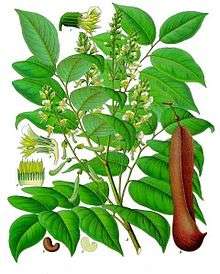Tolu balsam

Tolu balsam is a recent (non-fossil) resin that originates from South America (Colombia, Peru, Venezuela), similar to Balsam of Peru.
It is tapped from the living trunks of Myroxylon balsamum (see Myroxylon). It is a brownish, sticky, semisolid mass.[1] An essential oil is also distilled from the balsam. The balsam contains a fairly large amount of benzyl and cinnamyl esters of benzoic and cinnamic acid (benzyl benzoate, benzyl cinnamate).[2]
Uses
The resin is still used in certain cough syrup formulas. However its main use in the modern era is in perfumery, where it is valued for its warm, mellow yet somewhat spicy scent.
It is also used as a natural remedy for skin rashes. Ironically, it is a well known cause of contact dermatitis, a form of skin allergy.
Tolu has begun to be used in the niche perfume industry, notably by Ormonde Jayne Perfumery, which launched its oriental perfume Tolu in 2002, and also in 2010 by Esteban, which launched Baume Tolu. Both perfumes have a velvety rich quality.
History
In 1841, Henri Étienne Sainte-Claire Deville isolated toluene by the dry distillation of tolu balsam.[3] The resin, as well as the leaves and fruit, have been traditionally used by the people of Central America and South America to relieve coughs and asthma, and to treat wounds. Its name comes from Tolú (singular); Tolúes (plural), the name of the native precolumbian people that used to be the inhabitants at the same place where now is located Tolú, a small town and municipality in Sucre Department, northern Colombia (South America) by the Caribbean sea. Tolúes were the first reported to be using this resin in early Spanish chronicles.
Tolu balsam (M. balasamum) is named after Santiago de Tolu
References
- ↑ Klemens Fiebach; Dieter Grimm (2007), "Resins, Natural", Ullmann's Encyclopedia of Industrial Chemistry (7th ed.), Wiley, p. 4
- ↑ Karl-Georg Fahlbusch; et al. (2007), "Flavors and Fragrances", Ullmann's Encyclopedia of Industrial Chemistry (7th ed.), Wiley, p. 116
- ↑ Jörg Fabri; et al. (2007), "Toluene", Ullmann's Encyclopedia of Industrial Chemistry (7th ed.), Wiley, p. 4